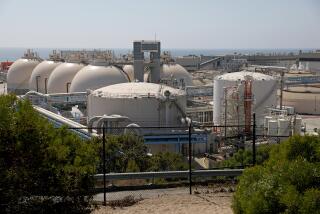State OKs Bleach Use for Ocean Sewage Line
- Share via
State water officials gave the Orange County Sanitation District approval Friday to use up to 25,000 gallons of bleach a day to disinfect the moderately treated sewage it pipes four miles offshore.
The chlorination plan may do more than protect beachgoers’ health--it should finally prove whether any of the 243 million gallons of waste water pumped off the coast daily is returning to pollute Huntington Beach’s coastline.
“The district believes that the disinfection of its waste-water discharge is in the best interest of the community,” Bob Ghirelli, director of technical services for the sanitation district, told the Santa Ana Regional Water Quality Control Board. “Your action will help assure beachgoers that the coastal waters of Orange County are safe.”
In addition to killing disease-causing microorganisms, the disinfectant “will remove the question of our impact on Huntington Beach’s bacterial problem once and for all,” said Blake Anderson, district general manager.
The chlorine kills the three types of bacteria coastal water is tested for, so if high bacteria counts persist at area beaches, Anderson said that would prove the waste water plume isn’t to blame. Millions of dollars have been spent on studies, yet there has been no conclusion about whether the plume is responsible for beach-closings and warnings that have plagued Surf City.
Approval of the chlorination plan comes two days after the sanitation district’s board of directors voted narrowly to step up waste-water treatment. In doing so, the board agreed not to seek renewal of a federal waiver that has allowed the agency to dump sewage treated to a lesser standard than nearly all of the nation’s 16,000 sewer agencies.
The waiver vote late Wednesday was a major victory for environmentalists. The bleaching plan, however, divided activists.
Some supported it, but with reservations. Others thought the district was rushing through the approval process without considering the potential harm to human health and the marine environment. Their concerns grew when they heard that the plan--which will cost $10 million the first year and $7 million in subsequent years--was not designed purely to focus on public safety, but rather was part a costly experiment.
“Is it designed for health protection, or is it designed to prove a point, that [the pollution] is not coming from the outfall,” asked retired Newport Beach physician Jack Skinner, a longtime proponent of cleaning up polluted waters.The district proposed the disinfectant plan after tests showed that the offshore plume was returning to within a half-mile of Newport Beach’s coastline.
Up to 25,000 gallons of bleach will be used daily at the agency’s Huntington Beach and Fountain Valley plants. Another chemical, similar to one used in aquariums, will then be added to neutralize the chlorinated waste water.
The regional board approved the plan 5-0 after two hours of testimony and discussion. Members required more stringent offshore testing in state waters, which extend three miles offshore. Board officials noted that the sanitation district went beyond what was required and agreed to make sure that the federal waters, where their the sewage is discharged, meets state standards within 185 feet of the outfall.
The U.S. Environmental Protection Agency also must approve the plan, said Terry Oda, an EPA hearing officer from San Francisco who attended the meeting.
Bleaching is expected to begin in mid-August. Anderson said the chlorine regimen, though used in 95% of the nation’s sewer plants, will be a temporary measure in Orange County.
The agency will have a long-term, nontoxic disinfection method, such as ultraviolet light, in place in three to five years, he said.
The promise that chlorination is a short-term solution pleased environmentalists.
Heather Hoecherl, a staff attorney with the Natural Resources Defense Council’s Los Angeles office, said the chlorine would kill the bacteria that the state uses as an indicator to judge the water quality at local beaches.
“Chlorine is much more effective at killing off indicator bacteria
Skinner added, “It’s tough to kill viruses with the level of chlorine being looked at” and with the length of time it would be in contact with the sewage.Hoecherl and others also expressed concern about byproducts that would be formed when the chlorine reacts with the sewage.
More to Read
Sign up for Essential California
The most important California stories and recommendations in your inbox every morning.
You may occasionally receive promotional content from the Los Angeles Times.














